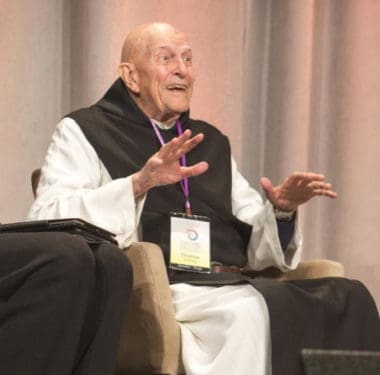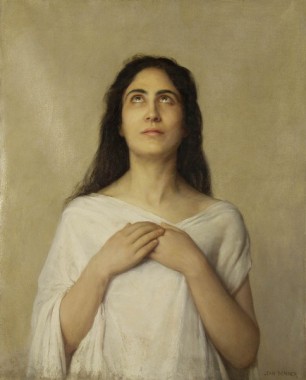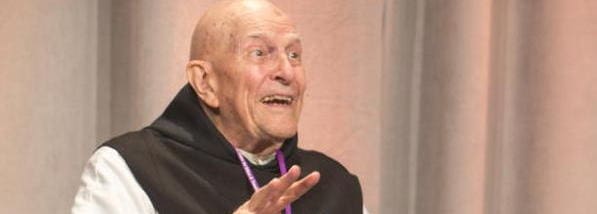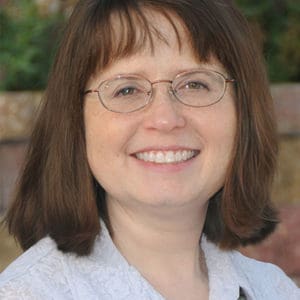Can I Trust Father Thomas Keating?
“Open Mind, Open Heart” Book Review
Trappist Abbot Thomas Keating is one of the foremost promoters of the practice of Centering Prayer. His book Open Mind, Open Heart, first published in 1986, has sold over half a million copies. Is this book a good resource for growth in prayer? Can I trust Fr. Thomas Keating as a guide to the spiritual life? In this post we’ll take an in-depth look at this book and the theology behind it.
 Fr. Keating, like all those who promote and teach Centering Prayer, claims to follow the tradition of Teresa of Avila, John of the Cross, Thérèse of Lisieux, and others. However, he provides no evidence to back up this claim. He quotes none of these saints. In fact, he has very few quotes from any Catholic sources and none that give us their complete context.
Fr. Keating, like all those who promote and teach Centering Prayer, claims to follow the tradition of Teresa of Avila, John of the Cross, Thérèse of Lisieux, and others. However, he provides no evidence to back up this claim. He quotes none of these saints. In fact, he has very few quotes from any Catholic sources and none that give us their complete context.
In the introduction, Keating describes Centering Prayer as a “specific method of awakening the gift of contemplation” (page ix).* In contrast, the Carmelite saints rarely speak of techniques or methods of prayer. Instead, they urge a life surrendered to Christ. In order to avoid such criticism, Centering Prayer advocates insist they are not teaching a “technique” but a “method.” They seem to think that substituting the synonym “method” for “technique” solves the issue. It does not. The real problem lies in the idea that we can attain to infused contemplation by following a set of steps in our prayer time, thus making states of consciousness more central than Christ. Such an idea is antithetical to the teaching of the Carmelite saints. Humility, perseverance in prayer and virtue, and faithfulness to God’s grace throughout the day–supported by growing detachment to created things–are what constitute the necessary preparation for contemplative prayer.
Throughout Open Mind, Open Heart, Keating over-emphasizes the soul’s role in attaining contemplation. I expected this would be the case from what I already knew about Centering Prayer. What surprised me were the many theological errors I found–some of them egregious. To be fair, a few of Keating’s descriptions of how the soul should behave during Centering Prayer are very close to orthodox teaching about acquired contemplation–the final stage of prayer in the Purgative Way. But we must remember the adage lex orandi, lex credendi–prayer is the expression of what we believe. If our theology is bad, our method of prayer will also likely be bad.
I cannot address every error in the book in a blog post, so I will confine myself to those that are most troubling. Let’s look at Keating’s teaching about the nature of God, man, sin, redemption, and the proper focus of our prayer.
1. Who is God?
Perhaps the greatest error, and the one most widely known, is Fr. Keating’s blurring of the distinction between God and man. Accused of pantheism, he and other Centering Prayer advocates respond that they teach panentheism. Not only the term (which this book doesn’t use), but its meaning, contradicts true Catholic spirituality. Here is just one quote among many that shows the problem:
“God and our true Self are not separate. Though we are not God, God and our true Self are the same thing” (158).*
In orthodox Catholic teaching, even at the highest stages of union with God, the soul always remains a distinct personality.
Another problem centers on our ability to know God. Keating writes that we don’t know exactly who or what God is (41),* and as we mature in faith, we do not even want to know (66).* This is repudiated by such Scripture passages as this:
“Beloved, we are God’s children now; what we will be has not yet been revealed. What we do know is this: when he is revealed, we will be like him, for we will see him as he is.” (1 John 3:2)
In other words, we do not fully understand God now, but our spiritual transformation entails knowing Him as He is. Our desire to know Him, as well as our understanding itself, move in the opposite direction that Keating proposes.
2. Who is Man?
Writing about the method of Centering Prayer, which involves letting thoughts slip past your mind without taking notice of them, Fr. Keating says the method prepares one to accept that “when the body slips away from the spirit, no great change is going to take place” (53).* He does not elaborate, but he is obviously speaking of death, the separation of the soul from the body. If death brings “no great change,” why do we need a resurrection? The body is an essential part of the human person. And, we profess the resurrection of the body in the Creed every Sunday at Mass, and every time we pray the Rosary.
3. Sin and Redemption
Fr. Keating writes that the main thing separating us from God “is the thought that we are separated from Him” (33).* This same error shows up in his discussion of Baptism, in which he says “our sense of separation from God and from others is destroyed” (159)* and is in his definition of original sin, wherein he repeats the error that separation from God is an illusion. Of course, separation from God due to sin is a reality (cf Catechism of the Catholic Church, paragraphs 1849-1850), not an illusion that we must be set free from.
How can we grow towards union with God? Keating says repeatedly that our thoughts and emotions are what primarily keep us away from Him. (See, for example, page 164.)*
4. The Focus of Prayer
 Finally, Fr. Keating gets the focus of our prayer time entirely wrong. This may not seem like such a big deal, until one reads exactly what his error is. This is where the bad theology ends in a bad prayer method. The focus is completely off.
Finally, Fr. Keating gets the focus of our prayer time entirely wrong. This may not seem like such a big deal, until one reads exactly what his error is. This is where the bad theology ends in a bad prayer method. The focus is completely off.
Keating writes, “The method consists of letting go of every kind of thought during the time of prayer, even the most devout thoughts” (21).* He clearly states more than once that this includes every type of communication and inspiration coming from God Himself. He urges his followers to use a “sacred word” during prayer, but not only can that word be something completely secular if one chooses, Keating says that “the less the word means to you, the better” (40).*
Where is Christ in this prayer? He is not at the center of it. Keating, without any evidence to back up his assertion, states that God’s first language is silence, so that, if we attain silence, God will come and fill it (48).* In contrast, we read in Scripture, “In the beginning was the Word, and the Word was with God. And the Word was God” (John 1:1). From all eternity, God has been speaking. The Word He speaks is God the Son. Jesus is God’s first and eternal language. If we are truly open to God in prayer, we will seek Him through His Son, not through a forced silence of the mind.
Elsewhere, Fr. Keating mentions Jacob’s dream of a ladder going up to heaven. Keating says the ladder “represents different levels of consciousness or faith” (90).* But in the Gospel, Jacob’s ladder represents Christ:
“[Jesus] said to [Nathanael] ‘…I say to you, you will see…the angels of God ascending and descending on the Son of Man.” (John 1: 51).
Some Closing Thoughts
In this post, we’ve examined some of the teachings about the nature of God, the nature of man, sin and redemption, and the focus of prayer according to Fr. Thomas Keating. We’ve demonstrated how Fr. Keating’s thought differs from authentic Catholic spirituality, by quoting from just a few of the many examples of error in his book Open Mind, Open Heart and showing how they differ from authentic Catholic spirituality. His text says a lot about how states of consciousness, in Centering Prayer, are more central than Jesus is.
Centering Prayer, as taught by Fr. Thomas Keating, is not traditional Christian prayer. It is based on a theology more influenced by Zen Buddhism than by the saints whose names Keating sprinkles throughout his text. It will not help a person prepare for infused contemplation. The evidence speaks for itself. My advice about Fr. Keating is to completely avoid his “theology”.
* Quotes from “Open Mind, Open Heart” are taken from the 20th Anniversary Edition (Bloomsbury: London, 2006).
Editor’s Note: Click here for more posts in our “Can I Trust?” Series.
Art: Detail from Thomas Keating, discussion with the Dalai Lama Boston 2012, “christopher”, 14 October 2012, CCA; L’Extase (The Ecstasy), Jean Benner (1836-1906), before 1896, PD-US; both Wikimedia Commons.




